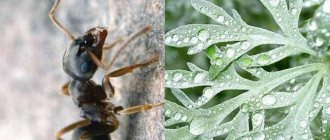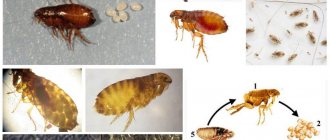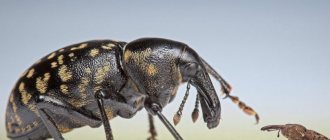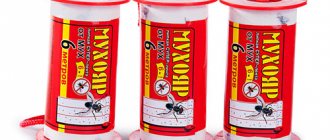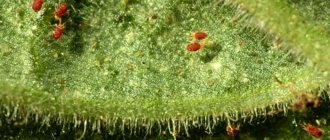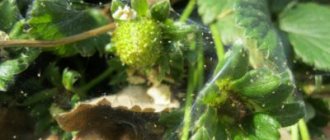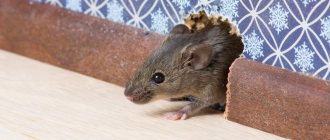LATEST NEWS
Finding an effective remedy for spider mites is not difficult: there are more than 100 drugs on sale today that, when treated with plants, kill all active stages of tetranychids.
Moreover, even with some folk remedies it is possible to wage a completely effective fight against these pests.
But choosing from them the optimal remedy for a particular situation is already a bit of a problem. At a minimum, because you still need to understand their diversity and understand what advantages and disadvantages need to be taken into account when choosing a product.
How to detect spider mites?
They often hide in leaves or soil. If there are too many pests, they will be quite noticeable. You should not look for individuals or their thin, barely noticeable webs, but for the skins that they leave behind after molting. They can be found on the back side of the foliage, which is a favorite place for these arthropods. Externally, the skins resemble small flakes of dandruff and are grayish or white in color.
There are several obvious signs by which you can determine that your green pet has been attacked by a spider mite (control and prevention measures are described in the article):
- the appearance of light or pale yellow spots on the leaves;
- the presence of small scales on the underside of the sheet;
- thin web on leaf blades.
How does flea shampoo for animals work against aphids, and what results does the treatment give?
A cat lives with me at the dacha and therefore I always have flea shampoo on hand. How does it work? Shampoos contain the substance permethrin, which kills aphids. And it doesn’t scare away, but kills. Therefore, this drug is much more effective than folk remedies. Permethrin affects the nervous system of arthropods, paralyzing them. Moreover, it works instantly, you will see the result immediately! There is no need to wait for the pests to eat something, something will get into the intestines and kill them.
Very important! For the product to work, be sure to make sure that the shampoo contains permethrin. In principle, even the cheapest shampoos have it, so if you don’t have animals, you can buy a shampoo just for pest control, it won’t be very expensive
By the way, the shampoo will also cope with caterpillars, cruciferous flea beetles, scale insects, and thrips.
What is very important, flea shampoo for animals is safe for people and naturally for the animals themselves. Yes, this is not an herbal infusion, and although it is chemical, it is not as caustic as standard insecticides
Therefore, shampoo is much safer than many store-bought drugs.
Why are spider mites dangerous?
Spider mites feed on plant sap and infect them with viral infections and gray rot spores that cannot be treated. The external color of the insect is green, yellow or red. It depends on the type of spider mite. The females of this insect reproduce at the “speed of light” - they are capable of hatching up to 100 eggs in a week.
You can notice the appearance of the pest by white dots on the back of plant leaves and a thin cobweb. The mite captures the plant, destroys its cells and slows down the process of photosynthesis. As a result, it gradually dies.
The following symptoms of infection are also identified:
- Falling of leaves and flowers;
- Slow growth;
- Excrement in the form of black spots;
- Many ticks hanging on the web.
There are four types of spider mites. The common one is omnivorous and can live in any climate except Antarctica. Red – loves ornamental plants. Atlantic - harms cucumbers. Turkestan - feeds on ornamental and garden crops.
MOST READ FROM PARTNERS
What cultures does it live on?
In the greenhouse, spider mites most like to settle on cucumbers.
They can also eat:
- Tomatoes
- Pepper
- Eggplants
- Melons
- All kinds of cereals
The tick can also settle in beds, but it doesn’t particularly like them, because it lives much better in a greenhouse.
What do you need to know about it?
A small bug up to 0.5 mm, it is impossible to discern the population on the plant with the naked eye. But the damage caused to culture is immediately visible. Despite its name, this pest is not related to mites, so many chemicals aimed at killing insects do not affect it.
Spider mites are arachnids. The insects have different colors: green in the summer and brownish-brown in the winter. They form their populations on the inside of the leaf.
Reference. When a plant is infected by this parasite, the leaves become covered with white or brown spots, and only then does it become clear that the population has reached large sizes.
It is difficult to destroy the pest - it is very viable. Even if the plant is placed in unfavorable conditions, the mite will not die, but will simply hibernate and wait for the right moment.
Spider mites are very common; they do not live only in Antarctica. But the most favorable conditions for reproduction and life are: temperature 20-35 degrees with air humidity 30-55%.
In June, the pest begins to actively reproduce in the open air, and in early September it goes into hibernation. To get rid of the pest, treatment must be carried out during the active period of life.
In an apartment, this pest can hide under the baseboards in the cracks of the window sill, crawl along the walls and ceiling. In winter, it may seem that it is not there, but as soon as a favorable period arrives, it will immediately move to indoor plants.
It is also worth knowing that a clutch of spider mite eggs remains viable for 5 years. You can bring this parasite home with clothes on the web.
Reproduction and development of spider mites
The fertility of ticks depends on the climate, time of year, the nutritional value of the plant on which they find themselves, the age of the females, and much more. Spider mites reproduce especially actively in dry weather at temperatures above 25°C. In tropical latitudes and greenhouses, their reproduction occurs continuously throughout the year. These arachnids can produce up to 20 generations in 12 months. In temperate climates, spider mite offspring appear once a year; in favorable weather, this number increases.
Fertilization in spider mites is not the same as in other acariform species: it is internal and occurs without the deposition of spermatophores (capsules filled with seminal fluid). Virgin development (without the participation of male reproductive cells) is also found. Unfertilized eggs produce only males with a single (haploid) set of chromosomes.
The development cycle of spider mites consists of the following phases:
- Egg
The spider mite egg is round, translucent, 1 mm in diameter. On average, per day, females lay 7 eggs with a stalk to attach them to a leaf or web. In summer, in temperate climates, they place eggs on the lower surface of leaves, and in winter they hide future offspring in cracks in the bark or in fallen leaves. Thus, at the egg stage, spider mites can easily survive the winter.
- Hemispherical larva
The spider mite larva is similar in lifestyle to the adult, but unlike it, it has 6 legs.
- Protonymph
It is slightly larger than a larva, with 4 pairs of legs and coloring characteristic of the species.
- Deutronymph
This stage is observed only in females. Males have only one nymph stage.
- Adult tick that looks like a larva (neoteny)
Neoteny is a phenomenon in which the achievement of sexual maturity and the end of ontogenesis occurs at early stages of development, for example, at the larval stage.
Spider mites become adults 10–20 days after emerging as eggs. At all stages except the larval stage, they have 8 legs.
Recommendations for tick treatment
Some gardeners are interested in how to deal with spider mites, because most acaricides and folk remedies are powerless against them. However, systematic work to destroy the pest always gives good results if you follow certain rules when treating bushes.
- Before processing, it is worth cutting off and burning all the most affected leaves. This will reduce the number of insects on the flower several times!
- Spider mites on indoor plants will not survive if acaricides or insectoacaricides are diluted according to the instructions. But they are sprayed not only on affected domestic crops, but also on those that grow close to them. If this is not done, the pest will move to a safe flower, survive and reproduce with the same effort, destroying indoor crops.
- First, the crops are sprayed with chemicals, and then the soil is moistened.
- Treatment with folk remedies is carried out more often than with acaricides. Do 3-4 sprays of the product 1-2 times a week. In this case, not only adult individuals are destroyed, but also young ones.
Flumite is a hormonal acaricide against spider mites on indoor plants
Important! Spider mites do not tolerate high humidity. So, as a preventive measure, you can arrange frequent spraying, watering
But such prevention is only suitable for those indoor crops for which an abundance of water is not dangerous.
After treating crops with folk or specialized preparations, you need to thoroughly wipe the surfaces where the pot stands with vodka. It is also advisable to wash the curtains if the plant is on the windowsill. If insects are frequent guests on indoor crops, it is necessary to carry out prevention at least once every half month. For prevention, you can give the plants a shower, and wipe the leaves with soapy water and rinse
If a shower is not recommended for the flowers, make a steam bath - close the windows and doors in the bathroom, turn on boiling water and leave the plant for a quarter of an hour. It is important to disinfect trays once a week. To do this, you can at least simply wash them with dishwashing liquid or wash them with boiling water.
Pots are disinfected only when replanting plants.
By following these simple recommendations, you can quickly destroy spider mites on indoor plants.
Spider mites are a dangerous pest that can multiply quickly. It depletes plants and leads to their death. But if you detect it in time and begin to destroy it, the cultures can be saved and they will quickly recover.
Types of spider mites
Each type of mite prefers to feed on the sap of certain plants. Therefore, it is advisable to know on which plants which mites settle. For example:
- Red tick. Prefers flowers such as balsam, lemon, rose, orchid.
- The broad mite is found on ficus, oleander, some types of cactus, and euonymus.
- Atlantic tick. It prefers to live on palm trees and citrus fruits, as well as on other plants. Lover of high humidity.
- Cactus mite or bryobia. As a rule, this parasite chooses exotic plants.
- Clover mite. Prefers bulbous plants, euonymus, orchids, ficus, peneromia.
- Cyclamen mite. Chooses flowers such as pelargonium, balsam, violet, chrysanthemum, gloxinia.
- Common tick. It can be seen on rose, dracaena, balsam, fuchsia.
- False tick. A very small parasite that is difficult to recognize with the naked eye. In addition, he does not spin webs. As a rule, most of the flowers on which this dangerous parasite has settled die.
Common types
The genus of spider mites includes many species. Their difference lies in the preferences of the plants on which they parasitize.
Ordinary
The most common species, characterized by omnivory. It parasitizes almost all types of agricultural crops and indoor flowers, excluding conifers. Females produce 3-5 clutches of eggs per year.
Red
A distinctive feature is that the females of this species have a bright red color. Damages indoor plants, preferring lemons, callas and orchids. The red tick is heat-loving and actively reproduces at temperatures above 25 degrees.
False
The pest parasitizes palm trees, orchids and citrus fruits. The body color is green, merging with the foliage, and may also have a red tint. This species is not capable of producing cobwebs, which, combined with its microscopic size (0.2-0.3 mm), greatly complicates its detection.
Wide
The broad spider mite prefers to inhabit plants indoors, so it poses a threat to indoor flowers. Cacti, ficus and citrus fruits suffer from its invasion. The eggs of this pest are visible on plants, which makes it easier to combat.
Clover
The main food of the clover spider mite is cereals. When this pest gets on indoor flowers, it damages them too. Longer legs (compared to other species) allow it to move quickly, capturing new plants. Peperomia and ficus trees are attacked.
Important! If you suspect that indoor flowers are infested with spider mites, you should inspect the plants using a magnifying glass. It is almost impossible to notice the pest with the naked eye, especially under artificial lighting.
Where do spider mites come from on houseplants?
There are a great many sources of spider mites appearing on house plants . We list both the most basic and the most unexpected, at first glance, routes of infection:
MOST READ FROM PARTNERS
Most often, the tick “arrives” in the house on the leaves of purchased indoor plants . All flower growers unanimously repeat: if you bought a new flower in a store or from hand, do not immediately place it on your plants. Place the newcomer in quarantine on a separate windowsill, or better yet, immediately wash the crown of the plant with laundry soap and carry out preventive spraying with any pest control agent.
The second most “popular” route of infection is flower bouquets . If you brought a bouquet of your garden flowers or were given one for a holiday, try to place the vase with flowers away from indoor plants.
In third place, spider mite infection through the ground . Experienced gardeners never prepare planting mixtures in the same room where the plants are located. Spider mite eggs can sleep peacefully in the ground for up to 5 years, waiting for favorable conditions. Any soil, forest garden soil or store-bought soil, must be calcined in the oven, because it may contain many dangerous bacteria, fungal spores and pest eggs.
The fourth way to become infected with mites perfectly explains how they “out of the blue” appear on plants. Attention! Spider mites can fly! Of course, they do not have wings, but the thin webs produced by the glands of the tick can serve as an excellent parachute, allowing them to soar with the wind over vast distances.
Home remedies
Things you will need:
magnifying glass (preferably 30x), water, plant spray, 4-5 tablespoons of dishwashing liquid, 1 cup of salicylic alcohol.
- Using a magnifying glass, carefully examine your indoor plants to see if they have been attacked by spider mites. Hold the glass over the plant and check for brown or black spots no larger than poppy seeds. Look for any nibbled shoots, leaves, stems or other signs of pests around the area.
- Spray the plants as often as possible and water regularly. Spider mites usually move downwards if the plant is well sprayed with water. Water washes away the remnants of the spider web and all the debris and tick activity. It will be good if you remove the plants to a room that is not too lit by the sun during the period of fighting the mite.
Water and dishwashing liquid
If the number of mites on a plant is small, then washing the infected plant leaves with warm water and a few drops of dishwashing liquid will be quite effective against them.
Mix 1 tablespoon of liquid dish soap and one liter of water. Pour the solution into a spray bottle. Spray the plant under the leaves to kill mites. The product kills pests as soon as it hits them. To stop further mite infestation, use the product after 7 days.
Dishwashing liquid can be sprayed on infected plants.
A solution of laundry soap and water
Treating with a solution of soap and water helps fight the mite, and you can also sprinkle the leaves with the remaining ash from a burnt cigarette.
In case of a pest attack on bush hydrangea or aromatic violet, cypress, a shower with strong water pressure for several days helps.
Vegetable oil
The underside of the leaf blade can be greased with vegetable oil. The oil coats the spider mite's body, creating a barrier and restricting air flow, which will ultimately suffocate the pest.
Soap and denatured alcohol solution
Another effective way to combat spider mites is to treat the back side of the plant leaf with a solution of laundry soap and denatured alcohol. To prepare the solution, you need to dilute 20 g of laundry soap and 10 ml of denatured alcohol in 1 liter of water. Mix the mixture thoroughly and spray using a hand sprayer.
It is very important to cover all parts of the plant with liquid. It's good if after spraying you can wrap the plant in a transparent film and let it stand for several days
The dark remains of spider mites will be visible on the transparent film. This will be a sign that the treatment was successful.
Denatured alcohol is the strongest poison for spider mites
Extract from garlic and onion peels
A good effect of killing spider mites is achieved using an extract from a clove of garlic and onion peel. Not only is it fatal to them, but it also prevents them from invading the plant again. The smell of garlic and onions acts as a deterrent for the spider to settle and spread on plants.
To prepare the extract, you need to finely chop the garlic cloves (about 25 g), pour 1 liter of cold water over them and leave for 12-14 hours. After this time, the solution should be decanted, diluted with cold water in a 1:1 ratio and sprayed on the plant. The extract is consumed during the day because it quickly loses its healing and deadly properties. The plant treatment should be repeated after 21 days to ensure that the pests have left your plants and are not returning.
Salicylic alcohol and water
Mix 1 cup alcohol with 1 cup water and pour the mixture into a spray bottle. Alcohol kills ticks on first contact. Water dilutes the alcohol enough to not harm the plant. Spray especially carefully the undersides of plant leaves where spider mites like to live.
Good to know!
In order to prevent the appearance of spider mites at home, which is especially important in winter, take care of additional humidity in the house - spray the plants with warm water more often
The back of the plant needs to be treated with salicylic alcohol.
Plan for treating plants with drugs
The plant treatment scheme is directly linked to the biological development cycle of the spider mite.
- The first spraying is aimed at destroying the bulk of adult individuals. Regardless of the drugs used, the majority of pests (70-80%) will be destroyed.
- The second should be carried out a week later, when new individuals hatch from the eggs.
- A third spraying is carried out again a week later for final destruction.
- Many experienced indoor crop lovers add a fourth spraying to eliminate possible remnants of the population.
Preventive measures
Almost all types of ticks, with the exception of a few species, cannot tolerate excess moisture. Many gardeners focus on this feature and successfully prevent the appearance of the parasite.
With proper care of indoor plants, it is possible to quickly recognize this dangerous pest and destroy it in time. Therefore, there are proven methods for preventing the appearance of various parasites. For example:
- Every three days it is recommended to wipe the leaves of indoor flowers and other ornamental plants with a damp cloth. To do this, you need to take hot water and rinse the rag well each time.
- Do not allow the soil to dry out.
- Constantly remove fallen leaves from the flowerpot, which can serve as a hiding place for ticks.
- Flowers are regularly fertilized and the desired temperature and humidity are maintained. If the plant is strong and healthy, then even ticks may find it too tough.
Novice gardeners believe that they can get rid of mites if they completely immerse the plant in water. Actually this is not true. Firstly, you can damage the flower itself, and secondly, an air bubble forms around the mite. Of course, if you keep a flower in water for several hours, the effect will be obvious, but it is unlikely that any flower will be able to withstand this. The most effective way is to wipe the leaves with hot water, but this method will not be effective if many spider mite colonies are found on the plant.
In order not to spend a lot of effort and energy fighting flat pests, it is better to adhere to certain rules for caring for indoor plants. If you really like flowers so much and can’t live without them, then you need to care for them properly.
Top Chemicals for 2022
When using drugs from this group, it is important to strictly follow the dosage and number of treatments in accordance with the attached instructions. Chemical agents that destroy ticks are divided into two groups:
- insectoacaricides;
- acaricides.
To effectively get rid of the pest, you should alternate products with different components in the composition. Many products cease to perform their function after repeated treatment.
If you need to use chemicals, you must follow a number of simple but important rules:
- During use, wear long sleeves, gloves and a hat to protect skin, mucous membranes and hair. The best place for spraying chemicals is a balcony, loggia.
- For indoor flowers, choose products with toxicity class 3-4. Highly toxic substances are only suitable for outdoor plants.
- In case of serious infection, it is necessary to carry out not one, but 4 treatments with an interval of 5-7 days.
Examples of chemicals and their use are presented in the table:
| Name | Protection time (days) | Peculiarities |
| Akarin | 8-15 | Provides assistance within 48 hours. Suitable for roses, violets and orchids. |
| Aktara | 14 | It does not have an unpleasant odor, but is considered ineffective against ticks. |
| Aktellik | Toxic, it is better to spray outside. Do not allow it to get into the ground. | |
| Anti-mite | 7-9 | Defeats different types of pests. |
| Apollo | 60-90 | Sterilizes adults. |
| Bi-58 | 21 | Prevents the emergence of new colonies of parasites. |
| Nissan | 50 | The effect is visible after 11 days. |
| Neoron | 10-40 | Can be used at any humidity and air temperature. |
| Omite 30 and 57 | 14 | Available in different dosages. |
| Oberon | 20-25 | Destroys all stages of insects: eggs, larvae, adult females, except males. |
| Sunmite | 30-35 | The impact on masonry is minimal. |
| Skelta | 80-85 | The death of the pests occurs within a week. Requires re-spraying after 8 days. |
| Fitoverm | 20 | Low toxicity, but re-treatment is required. |
Due to the fact that all mites are similar in structure, flower growers use drugs used in veterinary medicine to treat animals, for example, Neostomozan.
For treatment to be effective, it is better to alternate the use of acaricides and water procedures. Plants in large tubs, as well as specimens with curled leaves or curly dense crowns, for example, ficus, are best dipped into a bucket with diluted products, greens side down, for 1-2 minutes.
MOST READ FROM PARTNERS
Sometimes on forums they suggest using Dichlorvos. This should not be done, the product does not help against ticks, but when sprayed in an apartment it is harmful to human health.
Almost everyone has to fight spider mites, which attack vegetable crops in open ground and greenhouses, and also often appear on indoor plants, from time to time. The pest is tiny in size, but can adapt to different living conditions. The only solution is to regularly treat the plants using special means to combat the parasite.
Effective drugs against spider mites will help save flowers in the apartment, protect cucumbers and other vegetable crops in the garden. There are many means available for these purposes. They differ in price, composition and principle of action.
The best insecticides for pests
How to fight the pest. Spider mites on indoor plants are destroyed by acaricides or insectoacaricides.
- "Actellik" is a non-systemic insectoacaricide. Works at any stage of growth. It is classified in the second class of harmfulness, therefore it is recommended for use not in an apartment, but on the street.
- "Karate" is an insectoacaricide. Suitable for use at any stage of insect life. Class 3 harm.
- "Apollo" is a hormonal drug. Not dangerous. Sterilizes adult insects, they stop reproducing and therefore the colony dies out.
- "Bitoxibacillin" is a biological preparation. Not harmful, has an intestinal effect, but kills only adult ticks.
- "Demitan" is a slightly toxic acaricide. May be addictive, so its use is not recommended often.
Interesting! Insecticides for spider mites are harmless. They will not help get rid of them, and will not have any effect. Only insectoacaricides and acaricides can solve the problem with spider mites on flowers.
Bitoxibacillin - a biological preparation for spider mites on indoor plants
- Nissoran is a hormonal drug. It makes adult individuals infertile and destroys young ones, as a result, the number sharply decreases and the colony dies out.
- "Sunmite" is a contact acaricide of moderate danger. Effective on individuals of all ages. The main disadvantage of the product is that pests quickly adapt to it.
- "Flumite" is a hormonal acaricide. It is used only once, because it is addictive. Effective on spider mites of any age.
Also, among the high-quality drugs that can destroy ticks, it is worth mentioning: “Omite”, “Talstar”, “Skelta”, “Envidor”.
Folk remedies
It is best to start fighting ticks using traditional methods. Not only will the plants not suffer from them, but nothing will happen to humans either.
- Fill a bucket of water and pour 30 milliliters of ammonia inside.
- Mix thoroughly.
- Water the stems and leaves regularly.
- Also constantly wipe the walls and doors of the greenhouse with the resulting mixture.
Tomato tops
The tomato tops that remain after harvesting will be an excellent tool in the fight against the pest.
You need to take about 0.5 kg of it and fill it with a bucket of boiling water. Further:
- place the bucket with tops on the stove and boil for 30 minutes;
- strain the resulting mixture;
- add soap shavings to it.
By watering with this mixture, you will get rid of not only ticks. In addition to them, it will be possible to destroy the ubiquitous aphids.
Fumigation
You will have to wait until the end of the summer season - usually this happens in early November.
MOST READ FROM PARTNERS
Further:
- harvest the remaining harvest;
- water the soil, getting rid of even the tiniest weeds;
- put on a gas mask and protective gloves;
- Moisten the surfaces thoroughly with water;
- place the checkers on stones or metal surfaces and then set them on fire;
- close the door to the greenhouse for several days;
- After this, you need to ventilate the room.
Dry wormwood
- Collect a kilogram of wormwood and chop the stems.
- Fill the grass with 10 liters of water.
- Cover the container with a lid and keep it out of the sun for 2 days.
- Place the bucket on the fire and wait until it boils.
- The liquid should bubble for ¼ hour.
- Dilute the resulting mixture with a bucket of water and begin spraying the greenhouse plants.
What does an insect look like?
It is difficult to see what a spider mite looks like with the naked eye. This is due to the small size of the insect: an adult individual barely reaches 5 mm in length. Insects can have different colors, depending on the variety (red, orange, green, etc.).
When examining a tick in detail through a magnifying glass, one can note the presence of small bristles on its long body, as well as several pairs of legs, with the help of which it deftly climbs leaves.
Pests hide in the soil of plants, under leaves or in the axils. It will not be difficult to notice a spider mite if it is actively reproducing and settling on a flower.
Let's consider the main types of pests that are found in human homes:
- Ordinary. The mite infects young shoots and the inside of leaves, easily spreading to other crops.
- Red. A distinctive feature of the tick is its bright red or orange color. Individuals are found less frequently than common insect species. They live on lemon trees and orchids.
- Atlantic. It is grown where there is high air humidity. Parasitizes exotic flowers: citrus trees, palms.
- Cyclomene is the most inconspicuous type of mite. It settles in flower tubers and on the inner surface of leaves. The parasite's web can be confused with ordinary dust, which complicates the process of pest control. The main condition for the reproduction and spread of the parasite is sufficient air and soil humidity.
Prevention of spider mite infestation of indoor plants
To protect flowers, minimize the risk of infection and not waste energy on treatment, it is better to perform the following preventive actions:
- Exercise caution when purchasing new plants or replanting existing ones.
- Conduct regular inspections for the presence of parasites.
- Disinfect the substrate, expanded clay for drainage, purchased in the store, with a solution of potassium permanganate or bake on a baking sheet (baking sleeve) in the oven for 40 minutes at a temperature of +180 °C. Another way is to steam the soil in a sieve with a layer of gauze in a water bath for 20 to 90 minutes. After the procedures, it is important to add yeast or other bacterial fertilizer.
- Treat with special fungicides such as Fitosporin, Alerin, Agat, Baktofit.
- Carry out a 2-3 week quarantine for newly arrived specimens.
- Give the greenery a periodic shower.
- To humidify the air by spraying from a spray bottle, however, it is best to purchase a humidifier.
Spider mites are a dangerous pest that damage a wide variety of indoor plants and cause trouble for gardeners. However, by following simple rules, performing preventive actions and carrying out consistent, systematic treatment, you can reduce the risk of infection to a minimum.
Effective methods of prevention
To prevent spider mite infestation, it is necessary to minimize the possibility of the pest entering the room. To do this, the following measures are followed:
- Before use, flower soil is calcined in the oven or frozen;
- every 3-4 weeks the plants are treated with low-toxic folk remedies;
- home flowers are inspected at least 2-3 times a week.
Spider mites are a serious threat to indoor plants, so it is strictly not recommended to neglect preventive measures. It is better to protect yourself from the appearance of a pest in advance than to then subject the plants to treatment with toxic chemicals.
1/5 — (1 vote)
Prevention of pest occurrence
In addition to means of combating spider mites, comprehensive prevention is also important.
It can be divided into 3 stages:
- in the spring - preparation;
- all season - current;
- before wintering - final.
In the spring, you need to clean the room after wintering and sterilize the soil. For this:
- wash the greenhouse structure with soapy water, after adding chlorine to it;
- dig up the soil to 25-30 cm;
- treat it with boiling water;
- cover the soil tightly with film for 3 days;
- fumigate the room with sulfur bombs;
- spill the soil with a one percent manganese solution.
During ongoing prophylaxis:
- high humidity must be maintained in the greenhouse;
- plant plants at a distance of one and a half meters;
- regularly inspect planted vegetables;
- remove parts of leaves on bushes;
- mulch the soil;
- spray the soil and plants with onion infusion.
Autumn:
- completely remove plant debris and various auxiliary structures;
- Dig the soil carefully, adding lime or phosphate fertilizers.
ACTUAL NEWS
You may also find the following materials useful:
- Pharmacy activated carbon: top 8 options for use in the country
- Why does the earth crack after watering, and what to do in this situation
- The best remedies for late blight on tomatoes: the most effective, how to treat
- What can be made from tomato tops: use herbal infusions
- When and what to feed garden cabbage: the best options for organic fertilizers
How can you remove insects at home?
After discovering spider mites on home flowers, it is necessary to urgently isolate the affected plants and begin treating them. Preventive measures should be applied to healthy plants. You can fight the pest using several methods: from special chemicals to the use of improvised means.
Chemical methods
Specialized preparations are used in cases of significant pest damage to flowers. The following are popular:
- Sunmite;
- Flumite;
- Apollo;
- Oberon;
- Floromite.
Important! When processing with chemicals, it is necessary to follow the safety measures specified by the manufacturer.
Biological drugs
Biological products are not as toxic as chemicals. But pets may be harmed by them, so the flowers being treated should not be within their reach.
The following biological preparations are used to control the pest:
- Vertimek;
- Aktofit;
- Agravertine;
- Akarin.
Attention! After treating flowers with biological products, mite eggs survive. Therefore, after a while, the processing procedure is repeated.
How to fight with folk remedies?
To combat ticks, improvised means are suitable. The following infusions and decoctions have proven themselves well:
- Onion infusion. Finely chop a medium-sized onion, then pour 1 liter of boiling water and leave for 4 hours. After time, the infusion is filtered and applied to the infected plant using a spray bottle.
- Infusion of celandine. 2 tablespoons of green parts of the plant are poured with boiling water and left for 4 hours. You need to treat the flower with the prepared infusion.
- Yarrow decoction. 100 grams of green mass of yarrow should be poured into 1 liter of boiling water and boiled over low heat for 3-4 minutes, then left to brew for 3-4 hours, strain and process the plant.
How to breed in greenhouses and conservatories
For large premises - greenhouses, conservatories, winter botanical gardens, infestation with insect pests means the gradual death of all plants, since mites spread at an enormous rate.
Scientists who have studied the problem of pest prevention believe that the fastest and safest method is biological destruction, that is, the use of natural enemies.
Predatory individuals are released onto the affected areas and quickly deal with the prey. According to research, using this method at home is unprofitable. 2 – 3 flowers can be treated with herbal remedies.
If it is not possible to order natural enemies, you can equip the room with ultraviolet lamps and turn them on periodically. Ultraviolet light destroys eggs.
